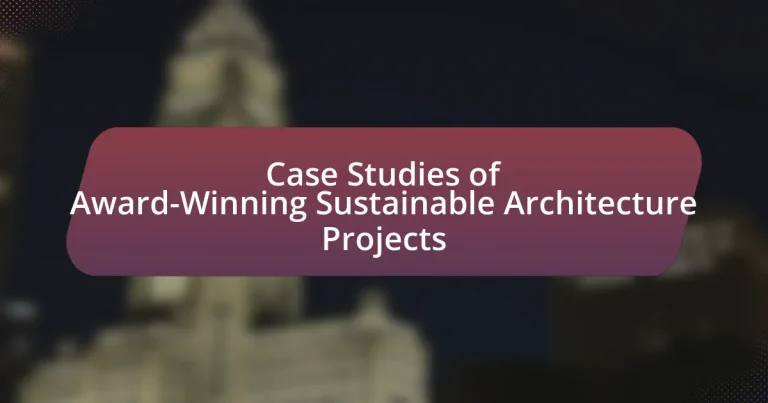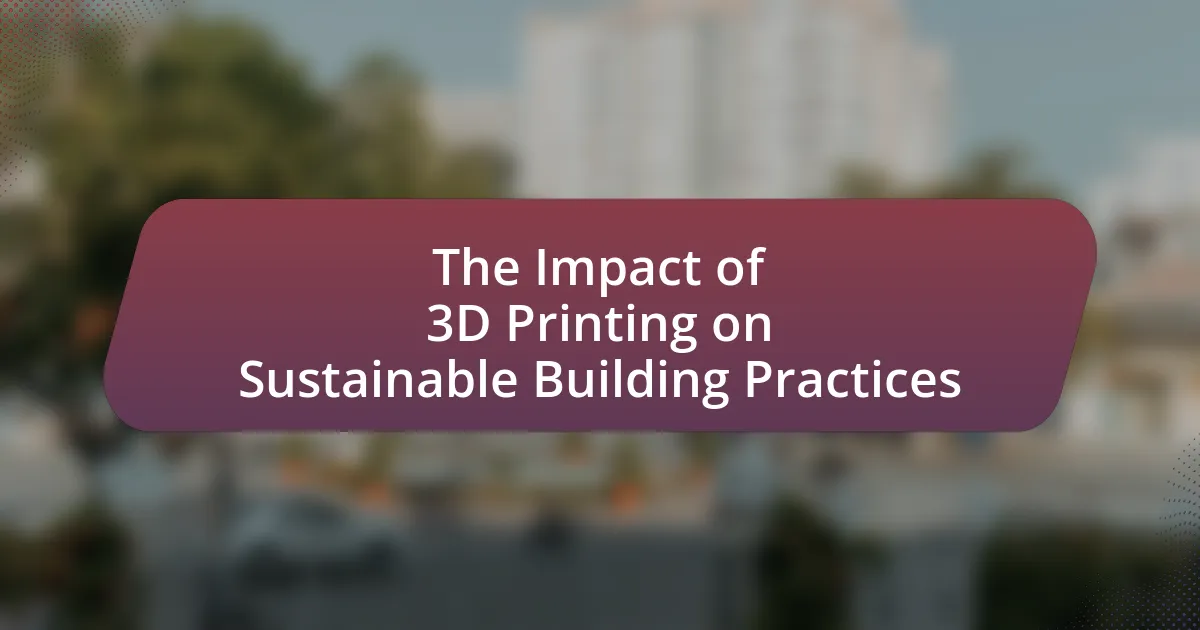Award-winning sustainable architecture projects are recognized for their innovative designs that prioritize environmental sustainability, energy efficiency, and social responsibility. This article explores notable case studies, such as the Bosco Verticale in Milan and the Bullitt Center in Seattle, highlighting their unique features, evaluation criteria, and the organizations that recognize them. It also discusses the importance of sustainability in architecture, the environmental impacts of traditional practices, and the innovative solutions implemented in these projects. Additionally, the article examines community engagement, future trends, and best practices for aspiring architects in sustainable design.

What are Award-Winning Sustainable Architecture Projects?
Award-winning sustainable architecture projects are designs recognized for their innovative approaches to environmental sustainability, energy efficiency, and social responsibility. These projects often incorporate renewable materials, minimize waste, and utilize energy-efficient technologies, contributing to a reduced ecological footprint. For instance, the Bosco Verticale in Milan, Italy, won the International Highrise Award for its vertical forest design that enhances biodiversity and improves air quality. Such projects are evaluated based on criteria like sustainability, functionality, and aesthetic appeal, often receiving accolades from organizations such as the American Institute of Architects and the World Architecture Festival.
How are these projects defined and recognized?
Award-winning sustainable architecture projects are defined by their innovative design, environmental impact, and adherence to sustainability principles. These projects are recognized through various awards and certifications, such as LEED (Leadership in Energy and Environmental Design) and the AIA (American Institute of Architects) awards, which evaluate criteria like energy efficiency, resource conservation, and community engagement. For instance, the Bullitt Center in Seattle received the Living Building Challenge certification, showcasing its commitment to sustainability through features like rainwater harvesting and solar energy use. Such recognitions validate the projects’ contributions to sustainable development and set benchmarks for future architectural endeavors.
What criteria are used to evaluate sustainable architecture projects?
Sustainable architecture projects are evaluated based on criteria such as environmental impact, energy efficiency, resource conservation, and social responsibility. Environmental impact assesses how the project affects local ecosystems and biodiversity, while energy efficiency measures the building’s ability to minimize energy consumption through design and technology. Resource conservation focuses on the sustainable use of materials and water, ensuring that resources are not depleted. Social responsibility evaluates how the project contributes to community well-being and inclusivity. These criteria are essential for determining the overall sustainability and effectiveness of architectural designs in addressing environmental challenges.
Which organizations or awards are prominent in this field?
Prominent organizations and awards in the field of sustainable architecture include the American Institute of Architects (AIA), the Royal Institute of British Architects (RIBA), and the LEED certification program by the U.S. Green Building Council. These entities play significant roles in promoting sustainable design practices and recognizing excellence in architecture. For instance, the AIA’s Committee on the Environment awards highlight projects that exemplify sustainable design principles, while RIBA’s awards celebrate innovative architecture that contributes to environmental sustainability. LEED certification is a widely recognized standard for measuring building sustainability, influencing architects and builders globally.
Why is sustainability important in architecture?
Sustainability is important in architecture because it minimizes environmental impact while promoting resource efficiency. Sustainable architecture incorporates design strategies that reduce energy consumption, utilize renewable materials, and enhance the well-being of occupants. For instance, buildings designed with sustainable practices can reduce energy use by up to 50% compared to conventional structures, as evidenced by the U.S. Green Building Council’s LEED certification program, which encourages energy-efficient designs. This approach not only addresses climate change but also fosters healthier living environments, making sustainability a critical consideration in modern architectural practices.
What environmental impacts do traditional architecture practices have?
Traditional architecture practices have significant environmental impacts, primarily through their use of local materials and energy-efficient designs. These practices often minimize the carbon footprint by utilizing natural resources that are abundant in the region, reducing the need for transportation and the associated emissions. For example, traditional adobe structures in arid climates leverage thermal mass to regulate indoor temperatures, decreasing reliance on artificial heating and cooling systems. Additionally, many traditional methods incorporate passive solar design, which optimizes natural light and ventilation, further enhancing energy efficiency. Studies have shown that buildings designed with these principles can reduce energy consumption by up to 50% compared to modern constructions that rely heavily on mechanical systems.
How does sustainable architecture address these impacts?
Sustainable architecture addresses environmental impacts by integrating energy-efficient designs, utilizing renewable materials, and promoting resource conservation. For instance, buildings designed with passive solar heating reduce energy consumption by maximizing natural light and minimizing reliance on artificial heating and cooling systems. Additionally, the use of recycled materials in construction decreases waste and lowers the carbon footprint associated with new material production. Research indicates that sustainable buildings can reduce energy use by up to 50% compared to conventional structures, demonstrating their effectiveness in mitigating negative environmental impacts.
What are the key features of sustainable architecture?
The key features of sustainable architecture include energy efficiency, use of renewable materials, water conservation, and minimal environmental impact. Energy efficiency is achieved through design strategies that reduce energy consumption, such as passive solar heating and high-performance insulation. The use of renewable materials, like bamboo and recycled steel, minimizes resource depletion and promotes sustainability. Water conservation techniques, including rainwater harvesting and low-flow fixtures, help reduce water usage. Additionally, sustainable architecture aims to minimize environmental impact by integrating buildings into their natural surroundings and promoting biodiversity. These features collectively contribute to a more sustainable built environment.
What materials are commonly used in sustainable architecture?
Common materials used in sustainable architecture include bamboo, reclaimed wood, recycled metal, and rammed earth. Bamboo is favored for its rapid growth and strength, making it a renewable resource. Reclaimed wood reduces waste and minimizes the need for new timber, while recycled metal, such as aluminum and steel, lowers the environmental impact of mining and processing new materials. Rammed earth provides excellent thermal mass and is made from natural materials, contributing to energy efficiency. These materials collectively support sustainability by reducing resource consumption and promoting eco-friendly building practices.
How do design principles contribute to sustainability?
Design principles contribute to sustainability by guiding the creation of buildings and spaces that minimize environmental impact and enhance resource efficiency. For instance, principles such as passive solar design, which optimizes natural light and heat, reduce energy consumption significantly. According to the U.S. Department of Energy, buildings designed with these principles can achieve energy savings of up to 30% compared to conventional designs. Additionally, the use of sustainable materials, as emphasized in design principles, reduces waste and promotes the use of renewable resources, further supporting sustainability goals.
How do case studies illustrate the principles of sustainable architecture?
Case studies illustrate the principles of sustainable architecture by providing real-world examples of how design strategies effectively reduce environmental impact while enhancing user experience. For instance, the Bullitt Center in Seattle employs rainwater harvesting, solar energy, and natural ventilation, demonstrating the integration of renewable resources and energy efficiency. This building has achieved a net-zero energy status, showcasing the practical application of sustainable design principles. Additionally, the Bosco Verticale in Milan exemplifies biodiversity and urban greening, as its vertical gardens improve air quality and reduce urban heat. These case studies serve as tangible evidence of how sustainable architecture can be successfully implemented, offering valuable insights for future projects.
What lessons can be learned from these case studies?
The lessons learned from case studies of award-winning sustainable architecture projects include the importance of integrating environmental considerations into design, the value of community engagement, and the effectiveness of innovative materials and technologies. These projects demonstrate that sustainable architecture can enhance energy efficiency, reduce carbon footprints, and improve occupant well-being. For instance, the Bullitt Center in Seattle showcases how a net-zero energy building can be achieved through careful planning and the use of renewable energy sources, proving that sustainability is not only feasible but also beneficial for both the environment and the economy.

What are some notable case studies of award-winning sustainable architecture projects?
Notable case studies of award-winning sustainable architecture projects include the Bosco Verticale in Milan, Italy, which won the International Highrise Award in 2014 for its innovative vertical forest design that integrates biodiversity into urban living. Another example is the Bullitt Center in Seattle, USA, recognized as one of the greenest commercial buildings in the world, achieving the Living Building Challenge certification by utilizing solar energy, rainwater harvesting, and composting toilets. The Eden Project in Cornwall, UK, also stands out, having received multiple awards for its sustainable design that features biomes housing diverse plant species, promoting environmental education and conservation. These projects exemplify how sustainable architecture can effectively address environmental challenges while achieving recognition for their innovative designs.
What are the most recognized projects in recent years?
The most recognized projects in recent years include the Bosco Verticale in Milan, Italy, and the Eden Project in Cornwall, UK. Bosco Verticale, completed in 2014, features residential towers adorned with over 9,000 trees and 20,000 plants, promoting biodiversity and improving air quality. The Eden Project, established in 2001, consists of biomes housing diverse plant species and has been pivotal in environmental education and conservation efforts. Both projects have received numerous awards for their innovative approaches to sustainable architecture, demonstrating significant contributions to ecological design and urban greening.
What makes these projects stand out in terms of sustainability?
These projects stand out in terms of sustainability due to their innovative use of renewable materials, energy-efficient designs, and integration with natural ecosystems. For instance, many award-winning sustainable architecture projects utilize locally sourced materials, reducing transportation emissions and supporting local economies. Additionally, they often incorporate advanced energy systems, such as solar panels and green roofs, which significantly lower energy consumption and enhance biodiversity. Research indicates that buildings designed with sustainability in mind can reduce energy use by up to 50%, demonstrating their effectiveness in minimizing environmental impact.
How have these projects influenced the field of architecture?
Award-winning sustainable architecture projects have significantly influenced the field of architecture by setting new standards for environmental responsibility and innovative design. These projects demonstrate the integration of sustainable practices, such as energy efficiency, use of renewable materials, and minimal environmental impact, which have become benchmarks for contemporary architectural practices. For instance, the Bosco Verticale in Milan showcases vertical forest concepts that enhance biodiversity and improve air quality, influencing urban design strategies globally. Additionally, the Bullitt Center in Seattle, often referred to as the greenest commercial building, has inspired architects to pursue net-zero energy designs, promoting a shift towards sustainability in urban environments. These examples illustrate how award-winning projects not only push the boundaries of architectural design but also advocate for a more sustainable future in the built environment.
What challenges did these projects face during development?
The projects faced significant challenges during development, primarily related to funding, regulatory compliance, and technical execution. For instance, securing adequate financing often proved difficult due to the higher upfront costs associated with sustainable materials and technologies. Additionally, navigating complex zoning laws and building codes posed hurdles, as many sustainable designs did not fit traditional regulatory frameworks. Technical execution challenges included integrating innovative systems, such as renewable energy sources and advanced insulation techniques, which required specialized knowledge and skills not always available in the local workforce. These factors collectively impacted project timelines and budgets, demonstrating the multifaceted nature of challenges in sustainable architecture development.
How were these challenges overcome?
The challenges in award-winning sustainable architecture projects were overcome through innovative design solutions, collaboration among multidisciplinary teams, and the integration of advanced technologies. For instance, architects utilized passive design strategies to enhance energy efficiency, such as optimizing natural light and ventilation, which significantly reduced reliance on artificial heating and cooling systems. Additionally, partnerships with engineers and environmental consultants facilitated the implementation of sustainable materials and construction practices, ensuring compliance with environmental standards. These approaches not only addressed specific project challenges but also contributed to the overall success and recognition of the projects in the field of sustainable architecture.
What innovative solutions were implemented?
Innovative solutions implemented in award-winning sustainable architecture projects include the use of renewable energy systems, such as solar panels and wind turbines, to reduce reliance on fossil fuels. These projects often incorporate green roofs and living walls to enhance biodiversity and improve insulation, thereby lowering energy consumption. Additionally, advanced water management systems, including rainwater harvesting and greywater recycling, are utilized to promote water conservation. For instance, the Bosco Verticale in Milan integrates vertical gardens that not only provide aesthetic value but also improve air quality and reduce urban heat. These solutions demonstrate a commitment to sustainability while addressing environmental challenges effectively.
How do these projects engage with their communities?
Award-winning sustainable architecture projects engage with their communities through participatory design processes, educational initiatives, and local partnerships. These projects often involve community members in the planning stages, ensuring that the designs reflect local needs and cultural values. For instance, the High Line in New York City was developed through extensive community input, transforming an abandoned railway into a public park that serves as a green space for residents and visitors alike. Additionally, many projects incorporate educational programs that promote sustainability practices, such as workshops on green building techniques. Collaborations with local organizations further enhance community ties, as seen in the case of the Bosco Verticale in Milan, which partners with local schools to educate students about urban biodiversity.
What role does community feedback play in sustainable architecture?
Community feedback is essential in sustainable architecture as it ensures that designs meet the needs and values of the local population. Engaging with community members allows architects to gather insights on environmental concerns, cultural significance, and social dynamics, which can lead to more effective and accepted sustainable solutions. For instance, projects like the Bosco Verticale in Milan incorporated local input to enhance biodiversity and community interaction, demonstrating that community involvement can lead to innovative designs that are both sustainable and socially relevant.
How do these projects promote social sustainability?
These projects promote social sustainability by fostering community engagement and enhancing social equity. Award-winning sustainable architecture projects often incorporate participatory design processes, allowing local residents to contribute their needs and preferences, which strengthens community ties. For instance, projects like the High Line in New York City transformed an abandoned railway into a public park, providing accessible green space that benefits diverse populations. Additionally, these projects frequently prioritize affordable housing and inclusive public spaces, ensuring that all community members can benefit from the developments, thereby reducing social disparities.

What are the future trends in sustainable architecture?
Future trends in sustainable architecture include the integration of smart technologies, the use of renewable materials, and a focus on biophilic design. Smart technologies, such as IoT systems, enhance energy efficiency and optimize resource management in buildings. The adoption of renewable materials, like bamboo and recycled metals, reduces environmental impact and promotes sustainability. Biophilic design, which incorporates natural elements into architecture, improves occupant well-being and connects buildings to their natural surroundings. These trends are supported by the increasing demand for environmentally responsible construction practices and the need to address climate change challenges.
How is technology shaping sustainable architecture?
Technology is shaping sustainable architecture by enabling the integration of advanced materials, energy-efficient systems, and smart design practices. Innovations such as Building Information Modeling (BIM) allow architects to optimize resource use and reduce waste during construction, while renewable energy technologies, like solar panels and geothermal systems, significantly lower a building’s carbon footprint. For instance, the Bullitt Center in Seattle, often referred to as the greenest commercial building in the world, utilizes rainwater harvesting, solar energy, and energy-efficient design to achieve net-zero energy consumption. These technological advancements not only enhance the sustainability of architectural projects but also promote a shift towards environmentally responsible building practices.
What emerging technologies are being integrated into sustainable designs?
Emerging technologies integrated into sustainable designs include advanced materials, renewable energy systems, smart building technologies, and biophilic design principles. Advanced materials such as self-healing concrete and recycled composites enhance durability and reduce environmental impact. Renewable energy systems, including solar panels and wind turbines, provide clean energy sources, significantly lowering carbon footprints. Smart building technologies utilize IoT devices for energy management and efficiency, optimizing resource use. Biophilic design principles incorporate natural elements to improve occupant well-being and reduce energy consumption. These technologies collectively contribute to the sustainability and resilience of architectural projects, as evidenced by award-winning designs that prioritize environmental stewardship and innovation.
How do these technologies enhance sustainability?
Technologies enhance sustainability in architecture by optimizing energy efficiency, reducing waste, and utilizing renewable resources. For instance, advanced building materials, such as recycled steel and low-impact concrete, minimize environmental impact during construction. Additionally, smart building systems, including energy management software and automated lighting, significantly lower energy consumption, with studies showing reductions of up to 30% in energy use. Furthermore, renewable energy technologies, like solar panels and wind turbines, enable buildings to generate their own energy, contributing to a net-zero energy goal. These innovations collectively support sustainable practices in architecture, leading to a reduced carbon footprint and promoting environmental stewardship.
What are the best practices for aspiring architects in sustainable design?
Aspiring architects in sustainable design should prioritize integrating energy efficiency, utilizing renewable materials, and engaging in community-focused planning. Energy efficiency can be achieved by designing buildings that maximize natural light and ventilation, which reduces reliance on artificial heating and cooling systems. The use of renewable materials, such as bamboo or recycled steel, minimizes environmental impact and promotes sustainability. Community-focused planning involves collaborating with local stakeholders to ensure that designs meet the needs of the community while preserving the local ecosystem. These practices are supported by the U.S. Green Building Council, which emphasizes the importance of sustainable design in reducing carbon footprints and enhancing quality of life.
What resources are available for learning about sustainable architecture?
Books, online courses, and academic journals are key resources for learning about sustainable architecture. Notable books include “Sustainable Architecture: Low-Tech Solutions” by David Bergman, which provides practical insights into eco-friendly design. Online platforms like Coursera and edX offer courses on sustainable architecture, often created by leading universities, allowing learners to access expert knowledge. Additionally, journals such as the “Journal of Green Building” publish peer-reviewed articles that present the latest research and case studies in sustainable architecture, ensuring that learners stay informed about current trends and innovations in the field.
How can architects stay updated on sustainability trends?
Architects can stay updated on sustainability trends by actively engaging with industry publications, attending conferences, and participating in professional organizations focused on sustainable design. For instance, subscribing to journals like “Sustainable Architecture” and “Journal of Green Building” provides insights into the latest research and case studies. Additionally, events such as the Greenbuild International Conference and Expo showcase innovative practices and technologies in sustainability. Membership in organizations like the American Institute of Architects (AIA) or the International Living Future Institute offers access to resources, networking opportunities, and continuing education on sustainability advancements.
What practical tips can be applied to sustainable architecture projects?
Practical tips for sustainable architecture projects include utilizing energy-efficient materials, incorporating renewable energy sources, and designing for natural ventilation. Energy-efficient materials, such as insulated concrete forms or recycled steel, reduce energy consumption and environmental impact. Incorporating renewable energy sources, like solar panels or wind turbines, can significantly lower a building’s carbon footprint. Designing for natural ventilation enhances indoor air quality and reduces reliance on mechanical cooling systems. These strategies are supported by studies indicating that buildings designed with sustainability in mind can reduce energy use by up to 50% compared to conventional designs.





